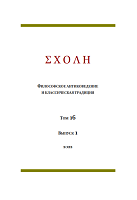«ОМОНИМЫ», «СИНОНИМЫ» И «ПАРОНИМЫ» В ПОЗДНЕАНТИЧНОЙ ЛОГИКЕ И ГРАММАТИЧЕСКОЙ ТЕОРИИ
HOMONYMS, SYNONYMS AND PARONYMS IN THE LOGIC AND GRAMMAR OF LATE ANTIQUITY
Author(s): Dmitrii ChernoglazovSubject(s): Theoretical Linguistics, Logic, Ancient World, Ancient Philosphy, Philosophy of Language
Published by: Новосибирский государственный университет
Keywords: homonyms; synonyms; paronyms; ancient logic; ancient grammar theory; Porphyry; Ammonius; John Philoponus; Simplicius; Olympiodorus; Dionysius Thrax;
Summary/Abstract: The subject of this article is the interpretation of the concepts “homonym”, “synonym” and “paronym” in the logic and grammatical theory of the Late Ancient / early Byzantine period (3rd–6th c.). Within the framework of the logical tradition, the theory of homonymy, synonymy and paronymy is developed, first of all, in the commentaries to Aristotle’s “Categories” written by Porphyry, Ammonius, Simplicius, etc., within the framework of grammatical theory – in the “Art of Grammar” by Dionysius of Thrace and its Byzantine scholia to it. Analysis of these texts shows that both disciplines paid great attention to these concepts: they were embedded in a broader terminological context; their definitions were refined and detailed; various methods of classification of homonyms and paronyms were developed. Many issues have been the subject of controversy and disagreement, for example, the problem of the relationship between metaphor, analogy and homonymy, or the methods of classification of homonyms. Significant disagreements persisted between the two disciplines: from the point of view of grammar and logic, all three concepts were interpreted differently, but the interpretation of synonymy differed most clearly. Contemporaries were aware of these contradictions between logic and grammar, noted and analyzed them.
Journal: ΣΧΟΛΗ. Философское антиковедение и классическая традиция
- Issue Year: XVI/2022
- Issue No: 1
- Page Range: 191-217
- Page Count: 27
- Language: Russian

